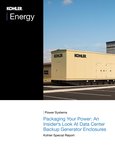Almost everyone is aware of data centers and realizes that they are important in the modern, connected world in which we live. However, the extent to which we rely on these information repositories will probably surprise the majority of the six billion individuals that analyst firm IDC predicts will be connected by 2025. IDC’s report (‘Data Age 2025’) goes on to forecast that each of these individuals will interact with a data center almost 5,000 times each and every day through home, office and cloud-based devices – almost three times the current daily rate. This widespread usage, along with the billions of deployed IoT nodes that generate data constantly mean that, by 2025, society is predicted to generate 175ZB of data each year – and the growth rate is accelerating.
Challenges for data centers
One of the greatest challenges for data centers is simply coping with the spiraling amount of data and the increasingly frequent user accesses to that data. Physical space is always at a premium and in many cases obtaining the necessary electrical power can be a challenge. In fact, many data centers are sited on redundant heavy industry sites, simply to inherit the valuable legacy electricity supply contracts.
Operating expenditure (opex) is generally significant for most data centers so, to remain competitive, they have to increase storage density and reduce running costs. Other than the power needed for the servers and other equipment, air conditioning (AC) for cooling is a significant opex and an area where data center operators focus cost saving efforts. One approach to this involves allowing equipment to run at an elevated temperature, thereby reducing the AC requirement, saving space and energy. In order to achieve this, the equipment installed in the data center has to be capable of operating with long-term reliability at these elevated temperatures.
There can be no question that the reliability of data centers is of prime importance, both in terms of data integrity as well as maintaining uptime 24 hours per day, every day of the year, for data access. However, there are many potential scenarios that can jeopardize this including equipment failure, power failure, sabotage and human error.
At the heart of guarding against power failure is the UPS system that is capable of powering the data center for a short time in an emergency. The battery capacity is sized to ensure 100% uptime, meaning that it needs to bridge the gap until generators are brought up to speed and loads can be transferred to the genset until grid power is restored. In the past, this ‘autonomy period’ would have generally been around 10 – 15 minutes although, as generators are increasingly automated or able to be remotely operated in under a minute, the typical autonomy period can be less than 5 minutes. This time reduction means that fewer batteries are required, thereby freeing up space that can be used to increase server and storage capacity.
Lead acid and TPPL batteries
The lead-acid chemistry has been a fundamental stalwart of energy storage for many decades, and over time there have been enhancements made to this technology. Traditional flooded lead-acid batteries, where excess liquid electrolyte is present, generate oxygen at their positive electrodes and hydrogen likewise at their negative electrodes, thereby causing water loss over time. Consequently, the electrolyte must be topped up with addition of water on a regular basis. It also means that relatively high levels of gas are generated, which require ventilation.
Valve regulated lead-acid (VRLA) batteries began to supersede the earlier lead-acid types. Here, the electrolyte is immobilized with either a gel or an absorbent glass mat (AGM) that significantly reduces electrolyte loss during operation and removes the need for topping up. VRLA technology also produces much less gas during operation, dramatically reducing the need and associated costs for ventilation.
AGM-based VRLA batteries that use a thick cast grid alloy of lead calcium / lead calcium tin have been the most commonly used batteries in data center UPS installations for several years. However, recently a new type of AGM VRLA battery that employs thin plate pure lead (TPPL) has moved lead-acid technology significantly further forward.
In TPPL based AGM VRLA batteries, thinner grids of very high purity are used to make the plates, resulting in an increase in the surface area which improves the contact between the grid and the active material. As these plates are inherently thinner, more of them can be stacked inside the battery, thereby increasing the energy density of TPPL batteries. In turn, this means that TPPL batteries can cope with larger peak currents as well as being able to (re)charge more quickly.
Benefits of TPPL technology in data center applications
TPPL batteries have greater longevity than standard AGM VRLA batteries and are able to provide a service life of around 8-10 years, an increase of approximately 25%. They also occupy around 20% less space which frees up space for revenue generating servers. The smaller size of TPPL batteries is highly compatible with the modern trend of modularizing data center installations.
TPPL batteries are also less affected by the higher operating temperatures associated with reduced AC, although the calculation as to what operating temperature represents the greatest overall reduction in total cost of ownership includes several factors and will therefore depend on individual data center configurations.
The ability of TPPL batteries to recharge more quickly than other types means that they are better able to deal with multiple outages during a short period of time. Additionally, the low inherent self-discharge means that, once charged, TPPL batteries can be stored for up to two years without requiring any additional charging.
Summary
As data centers continue to increase in importance, so the need for UPS backup and advanced battery technology also increases. The industry has relied on various forms of lead-acid batteries for decades, evolving into the latest generation TPPL-based type. These offer a number of advantages including lower maintenance, higher operating temperature, faster recharge, greater charge retention and increased power density, all of which enhance the ease of integration and help reduce the total cost of ownership.





